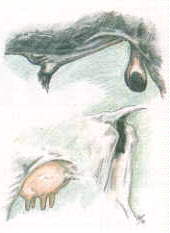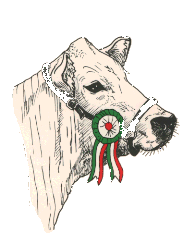

The Maremmana breed is a descendent of the bos Taurus Macroceros, a longhorned cattle that spread from the Eurasian steppes throughout Europe and that, in Italy, can be traced as far back as the Etruscan era, as evinced by the archeological findings from Caere (modern-day Cerveteri) and by the taurine head from the Vetulonia museum. This cattle (the bos Silvestris described by Pliny in his Natural History) was crossed with the Podolica cattle that reached Italy following the barbarian invasions, giving rise to the Maremmana breed which populated in enormous herds and has been a distinguishing feature of the marshy malarial zones of the Maremma areas in Tuscany and Latium. Maremmana breeders were exported from these areas to various regions and countries. The Grand Dukes of Tuscany sent breeders .from their holdings to Hungary to reinvigorate the Pustza breed. With the progressive reclamation of the marshlands, the breed underwent notable impetus between the First and Second World Wars; thanks to intensive selection work. After World War II a period marked by agricultural mechanization and farming reform, the breed decreased greatly in number. Added to this was the negative impact of replacement crossbreeding, which further decreased the number of bead as far as purity is concerned. Despite these events, the situation has been changing over the past few years. The Maremmana breed is reasserting its perfect suitability to the habitat that shaped it, populating areas that bad previously been off-limits. The breed is currently spread throughout the provinces of Grosseto, Viterbo, Rome, Terni, Latina, Pisa, Leghorn and Arezzo. The interest aroused by this breed has become even more intense lately; not only among certain breeders in southern Italy, but also among foreign breeders, particularly in Spain and Central America, who find that the Maremmana is the ideal means to make the most of particularly harsh environments.
A completely open-pasture system is used and the animals live outside yearround, taking full advantage of the vegetation and finding shelter in the bush during the winter. Calving is concentrated during the spring, when more abundant vegetation facilitates the dams in suckling their calves. Branding of one-year-old subjects is also done during the spring and the cows are herded together with bulls. The breeding season lasts about three months and about thirty dams are set aside for each bull. The calves, which are born in the springtime, are weaned in autumn. Summer pastures are composed of marshy and wooded areas, fields and grassy meadows in the well-irrigated farms. During the fall, the cattle go back to pastures that were already exploited during the spring, staying there until November, when they go to the bush for the winter. The bush offers shelter during the cold season, whereas nourishment comes from grassy pastures and from tree and shrubbery elements. The cattle feed on these resources, using their horns to clear the way through the dense vegetation. This type of diet needs to be supplemented to a minimal degree with straw. This simple breeding system entails just a minimal investment in terms of structures and labor and makes is possible for this very rustic breed to exploit difficult regions, producing feed-lot calves that are purebred or crossbred with other beef cattle breeds.
The first breeder associations aimed towards improving the breed were established following the conference held by Professor Giuliani in 1928 for the breeders in the Grosseto area. However, morphological selection work was already well under way by the most qua/i/5'ed cattle farmers, whose breeders were being purchased , by cattlemen from other areas. In 1932, based on a program proposed by Professor Giuliani, selection based on morphological conformation and on weight checks was initiated, achieving notable results in just a few years. Subsequently, the Association of Maremmana Breeders was founded and was later absorbed into ANABIC, which has been involved in the selection of this breed for quite some time now. The goal of the selection objectives is to produce rustic subjects that can be raised under open-pasture conditions with meager food resources, producing, long-lived cattle with good maternal capacities as well as high-quality beef. In this regard, it is important to outline the essential aspects of the current selection program that is based on the work conducted by the Bull-Calves Selection Center, the true driving force behind the genetic improvement of the Maremmana breed. This program makes it possible maximize progress according to the various types of farm organizations. All the herds run using a pasture system are divided into two groups:
A: groups using a single bull for each breeding group
B: groups using several bulls for each breeding group
The farms in group B produce replacement females but must acquire bulls produced by group A farms. The young bulls are selected on the basis of their productive characteristics and a/so according to the characteristics of their respective dams, which are selected for maternal capability and reproductive efficient7.
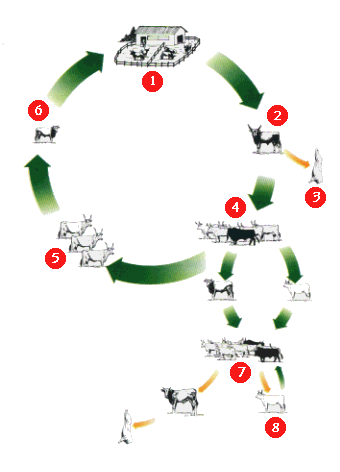 SELECTION GOALS AND SCHEME
SELECTION GOALS AND SCHEME
The selection program makes it possible to obtain maximum progress according to the various farm organizations. All the farms, which are run on a grazing system over a wide area, are divided into two segments A (4) and B (7). Only Group A herds which use just one bull for each breeding group, can supply male breeders. The herds in Group B (with more than one bull for each breeding group), produce females for replacement (8), but must acquire bulls from Group A. The young bulls are assessed and chosen in special centers (1) on the basis of their productive traits as well as the characteristics of their respective dams (5), which are selected for maternal capacity and reproductive efficiency.
Regardless of whether we are talking about bulls or cows, there are three parameters that must be taken into consideration in assessing breeders., productivity, genealogy and morphology. In beef cattle, where morphology also means function, the morphological evaluation becomes particularly important since it allows us to evaluate the capacity to produce muscle tissue and thus meat. In the past, far too much importance was given to aesthetic details due to the false assumption that there was a correlation between appearance and function. This inevitably led to formal evaluations that neglected the animal's true morphological and functional value and thus went beyond any logic of selection and genetic improvement. Consequently, evaluation methods needed to undergo radical changes. The concept of "outer beauty" was replaced with the concept of "functional beauty" that was aimed towards identifying animals with the functional and morphological traits to become excellent breeders according to the selective trends that the Association had set for itself. The first significant modification was made in 1986 when ANABIC introduced a new morphological evaluation sheet that attributes greater weight to muscle development traits as compared to other trait groups (skeletal structure and breed characteristics). The definitive turning-point came when the breed standard was revised. With the new standard, in addition to channeling selection towards animals that were closer to market requirements, the following objectives were also pursued:
-maximum emphasis on characteristics related to beef production
- greater tolerance towards 'formal" and non-functional morphological characteristics
-elimination of superfluous parts related to general zoognostic concepts
-maximum simplicity of explanation in order to avoid subjective interpretation.
Light bone structure, clean joints, impeccably-shaped feet, fine skin, marked longitudinal and transverse diameters, abdominal capacity well-suited for hard-to-digest foods, harmonious and perfectly functional overall aspect., these are the distinctive features of the Maremmana, whose lyre-shaped horns represent the characteristic trait of the breed.
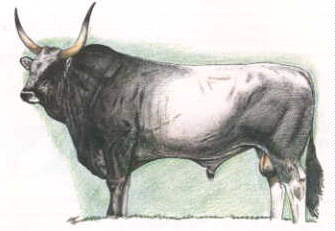
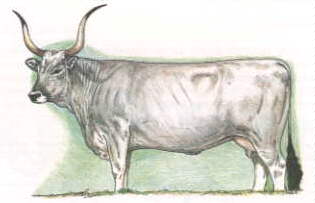
In this breed, sexual dimorphism is particularly marked as far as coat color is concerned. Calves are wheat-colored at birth and turn gray at around three months of age.
Pigmentation is highly evident and represents one of the traits common to other Italian beef cattle breeds, a feature that is especially valuable under conditions of severe solar radiation. The persistence of reddish hair exclusively around the poll area, a gray tail and partial depigmentation of the natural apertures, are tolerable in subjects with the functional-morphological requisites needed for listing in herd books.
Skin elasticity, relaxed aspect and oiliness, as well as proper function of the hairholding muscles are important in protecting the animal from skin parasites. In addition, the presence of an abundant dewlap is typical of breeds that developed in hot climates and is essential to adequate t thermoregulation.
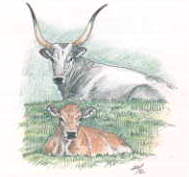
Sexual dimorphism is particularly evident in the head, which must be light and expressive, with a broad muzzle and strong cheeks. The horns, which are sturdier and half-moon-shaped in bulls and lyre-shaped in cows, are slate-gray in young animals. In adults, the horns turn yellowish-white at the base and black at the tips.
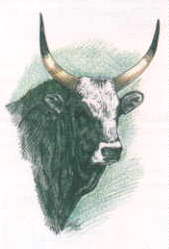
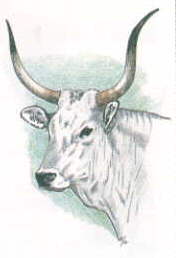
The neck is markedly convex along the upper line of the male, whereas it is straighter in females. The dewlap is particularly well-developed, especially in bulls, but it must not be overly abundant.
The shoulder muscles must evidence a somewhat convex profile.
This area must be broad and tend to be rather flat.
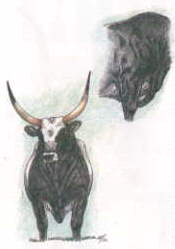
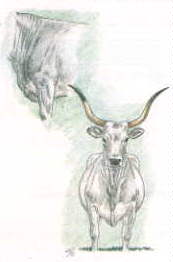
The muscles in this area must be well-developed.
This area, which is particularly important for productive purposes, must be muscular. It must not only be markedly long and broad but must also present an adequate degree of thickness.
This type of shape indicates adequate development of the rib cage.
In the Maremmana, the extremely pronounced development in the height of the rib cage stems from centuries of selection geared towards a good work capacity. In terms of greater emphasis on beef-production capacities, greater arching of the sides represents a desirable trait, along with the ensuing increase in the transverse diameters of this area.
Abdominal breadth is tied to adequate ingestive capacity in order to hold bulky food that has low nutritional value. Nevertheless, abdominal volume must not be excessive, nor should this area droop.
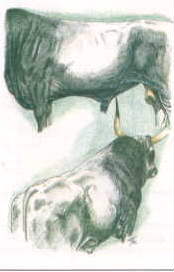
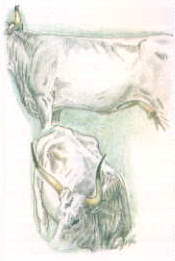
The skeletal base of this area, which has marked transiliac and transischial diameters, must ensure adequate support for an abundant muscle mass and must also facilitate calving and elimination of lochia. The sacral vertebrae and tail area must be have a regular and clean conformation.
The thickness and convexity of these areas is essential to the market value of beef- cattle breeds. Consequently, they represent an important selection objective for the Maremmana, in light of its development towards a typology that can better satisfy this productive trend.
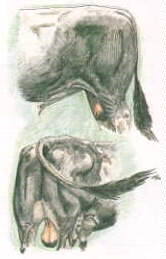
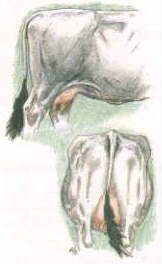
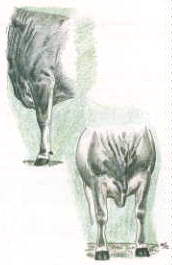
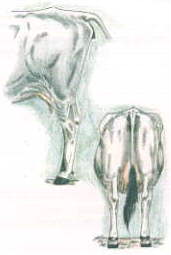
Properly-shaped legs and feet, good bone quality and movement are the intrinsic characteristics of this breed that have been consolidated through centuries of selection. These features continue to be essential even today, given the breeding conditions in which these animals are raised. The extremely functional aspect of the animal's anatomic base is evident in its elegant movement.
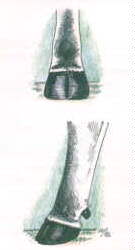
In order to ensure good maternal capacity, adequate development of the udder and, in particular, proper teat shape are prime importance as far as suckling is concerned, particularly during the first few days after birth.
Adequate and harmonious development of the testicles is fundamental to reproductive function. Any defects in terms of size or asymmetry in this area are not acceptable.
